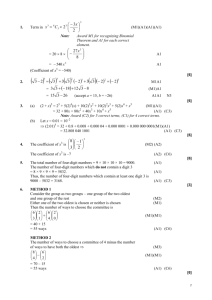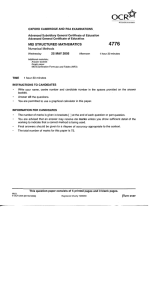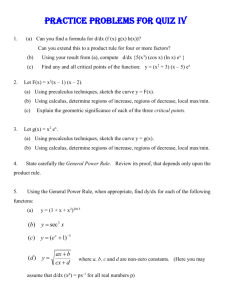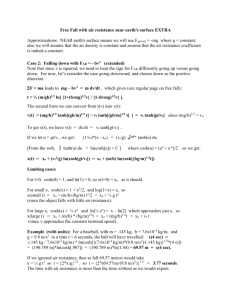Mark scheme - 6675 Pure P5 and Further Pure FP2 Jan 2006
advertisement
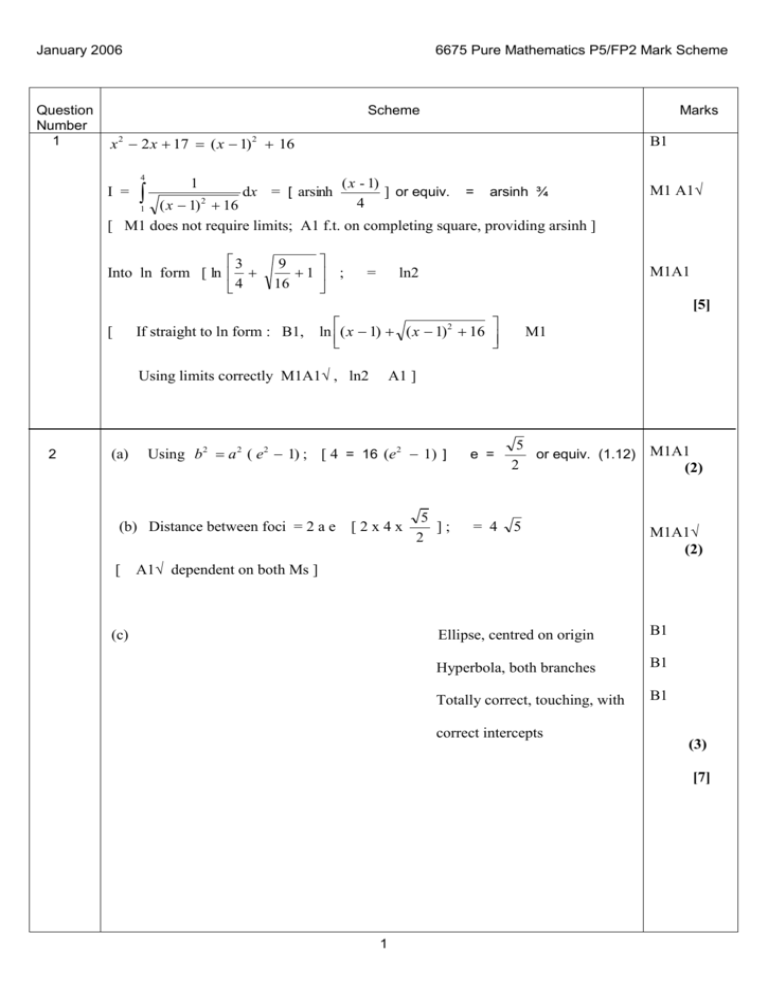
January 2006
Question
Number
1
6675 Pure Mathematics P5/FP2 Mark Scheme
Scheme
Marks
x 2 2 x 17 ( x 1)2 16
4
I =
1
B1
dx = [ arsinh
( x - 1)
] or equiv.
4
=
arsinh ¾
( x 1) 2 16
[ M1 does not require limits; A1 f.t. on completing square, providing arsinh ]
1
3
Into ln form [ ln
4
9
1 ;
16
=
M1 A1√
M1A1
ln2
[5]
[
If straight to ln form : B1,
ln ( x 1) ( x 1)2 16
Using limits correctly M1A1√ , ln2
2
(a)
A1 ]
Using b2 a 2 ( e2 1) ; [ 4 = 16 (e 2 1) ]
e =
5
or equiv. (1.12) M1A1
2
(2)
5
];
2
= 4
5
(b) Distance between foci = 2 a e [ 2 x 4 x
[
M1
M1A1√
(2)
A1√ dependent on both Ms ]
(c)
Ellipse, centred on origin
B1
Hyperbola, both branches
B1
Totally correct, touching, with
B1
correct intercepts
(3)
[7]
1
January 2006
3
6675 Pure Mathematics P5/FP2 Mark Scheme
dx
1 cos t ,
dt
s
dy
sin t ,
dt
(1 cos t )
2
(sin t ) 2 dt ;
Use of “half-angle formula”
B1
(both)
=
[ 4 cos t dt ] ;
2
Using limits correctly and surd form;
M1A1
2 2 cos t dt
(
t 2
s = 4 sin
2 ( 0)
= 2 √2 (allow
4
)
2
M1A1√
M1A1
[7]
4
(a) Using cosh x
e x e
2
x
and attempt to progress
e3 x 3 e x 3e x e 3 x
Correct intermediate step as far as 4
8
=
M1
e x e x
3
2
e 3x e 3x
cosh 3 x
2
A1 (3)
M1
(b) Using part (a) to reduce to cosh2x = [ 2 ]
Correct method to form ln x or find e X or e 2 x
x = ln
2 1 ,
ln
2 1
A1
or equivalent
or ½ ln 3 2 2 , ½ ln 3 2 2 ,
M1
A1 A1√
(4)
( after finding e 2 x = ……)
[7]
2
Question
Number
5
Scheme
dy
1
. sec x tan x tan x ;
dx sec x
s
2
dy
(1 dx
dx c
=
B1B1
x
M1
(1 tan xc2 dx
ln sec x tan x
sec x dx ;
s 0, x
Method to find “c”:
Marks
3
( c)
0 ln (2 3 ) c
ln (2 3 )
A1A1
M1
c = ln (2 3 ) or ln tan
s ln (sec tan )
or equivalent
5
or – 1.32
12
or equivalent
A1
A1√
[8]
6
(a)
dy
3 cosh 2 x sinh x
dx
B1
d2 y
3 cosh 3 x 6 cosh x sinh 2 x
dx 2
or equivalent
Application of formula for radius of curvature [ =
M1A1
1 9 cosh
1 9 c
(c 1)
3c {c 2(c 2 1)}
(b) cosh x =
2
2
2
3
2
x sinh x
]
3
3 cosh x 6 cosh x sinh 2 x
Use of sinh2 x = cosh 2 x 1
4
4
M1
M1
3
2
=
9c
9c 1
3c { 3c 2 2)}
6
4
3
2
5
4
AG
A1*
(6)
B1
Using found value of cosh x in formula for ; = 4.8
M1A1
(3)
[9]
3
4
7
(a)
3
3
4
2 n
2
n 1
2
I n x (4 x) n x (4 x) 2 dx
3
3 0
0
3
4
2
n x n 1 (4 x) 2 dx
3 0
=
A1√
1
4
1
4
2
2
n 4 x n 1 (4 x) 2 dx n x n (4 x) 2 dx
3 0
3 0
=
In
[ 2n 3I
n
8
nI
3
8n I
n 1
(b) Relating I 2 to I
I2 =
M1A1
16 8
.
7 5
I
0
n 1
]
2
nI
3
I
n
n
8n
I
2n 3
using result from (a)
0
=
2048
105
M1A1
53
19
105
n 1
AG
A1*
(6)
M1
A1A1
(3)
[9]
4
8
1
1
1
1
2
(a) ar tanh
ln
2 1 1
2
2
=
1 2 1
ln
x
2 2 1
=
1
ln
2
or equivalent
M1
2 1
or equivalent
2 1
M1
2
2 1 ln
2 1
AG
A1*
(3)
Alternative Approach
1
ar tanh (sin x) tanh y
2
and then use exponentials:
If using y
Progression as far as e y ....... or e2y .......
Converting to ln form
Answer as given
Note:
1
ln 3 2 2
2
[ or cosh2 y 2 ]
M1
M1
A1*
can earn M1M1 but for A1* there must be a
convincing further step.
(b)
dy
1
. cos x ;
dx 1 sin 2 x
cos x
sec x
cos 2 x
M1A1
(2)
Note: If tanh y sin x is differentiated M1 requires
dy
f ( x)
dx
(c) Attempt at by parts and use of result in (b)
= cos x ar tanh (sin x)
M1
cos x sec x d dx
A1
M1
= cos x ar tanh (sin x) x
Using limits correctly :
=
1
or exact equivalent
ln 1 2
4
2
5
M1A1
(5)
[10 ]
9
(a) Correct method for finding
1
P
dy
dx
M1
Gradient of normal = – p
A1
y 2ap ( p)( x ap 2 )
Equation of normal:
y px 2ap ap3
M1
AG
A1*
(4)
(b) Using both equations and eliminating x or y
M1
( p q) x 2a( p q) a ( p q )
3
3
may be unsimplified
A1
x 2a a ( p pq q )
2
2
A1
Finding the other coordinate
M1
y apq ( p q)
A1
(5)
(c) Using pq = 3 in both x and y
[ x a ( p 2 q 2 5),
(in any form)
y 3 a ( p q) ]
M1
Complete method for relating x and y, independent of p and q
M1
A correct equation, in any form
A1
[ e.g. :
x 5a
y 2 9 a 2 ( p 2 q 2 2 pq) = 9 a 2
6 ]
a
y 2 9 a ( x a)
A1√
(4)
[13]
6


